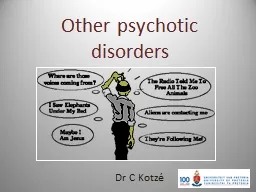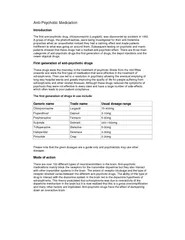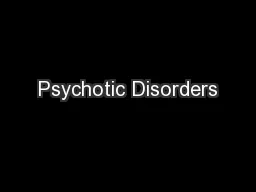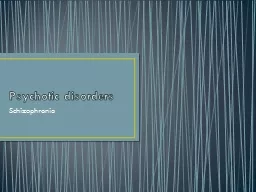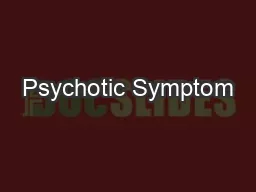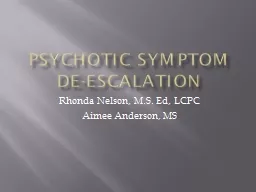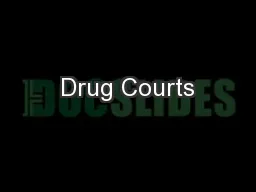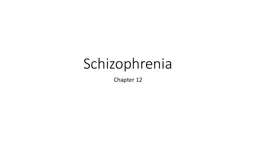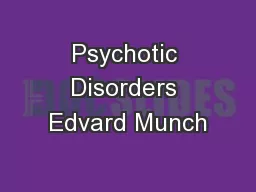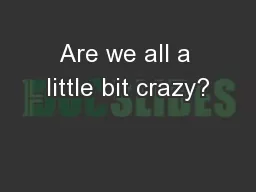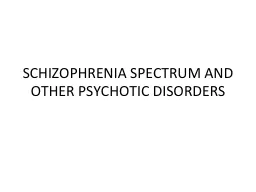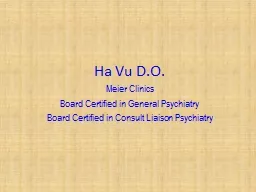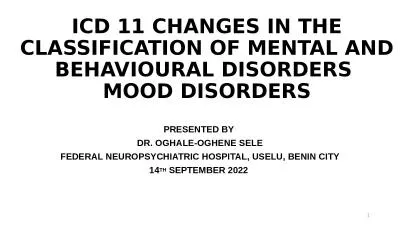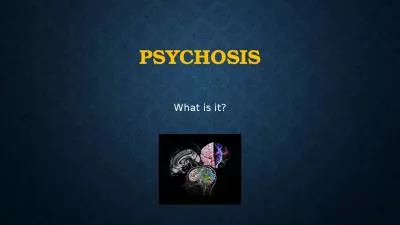PPT-Other psychotic disorders
Author : mitsue-stanley | Published Date : 2016-10-09
Dr C Kotzé Classification Schizophrenia Schizophreniform disorder 1 6 months Brief psychotic disorder 1 day 1 month Schizoaffective disorder Bipolar type Depressive
Presentation Embed Code
Download Presentation
Download Presentation The PPT/PDF document "Other psychotic disorders" is the property of its rightful owner. Permission is granted to download and print the materials on this website for personal, non-commercial use only, and to display it on your personal computer provided you do not modify the materials and that you retain all copyright notices contained in the materials. By downloading content from our website, you accept the terms of this agreement.
Other psychotic disorders: Transcript
Dr C Kotzé Classification Schizophrenia Schizophreniform disorder 1 6 months Brief psychotic disorder 1 day 1 month Schizoaffective disorder Bipolar type Depressive type Delusional disorder. Also its possible for otherwise healthy people to develop severe illness so any one concerned about their illness should consult their doctor There are emergency warning signs that should signal anyone to seek medical care urgently Emergency Warning ChlorpromazineLargactil75-400mg FlupenthixolDepixol3-10mg PerphenazineFentazin5-30mg SulpirideDolmatil200-1000mg TrifluperazineStelazine5-30mg HaloperidolSerenace3-30mg PimozideOrap2-20mg Please note A Patient-Centered, Evidence-Based Diagnostic and Treatment Process for Schizophrenia. 1,2,3. Kendall . L. Stewart, MD, MBA, DLFAPA. March 21, . 2014. 1. My aim is to offer practical clinical insights that you can use right away in caring for patients.. disorders. Schizophrenia. Characteristics of Psychotic . Disorders. A . psychosis. or . psychotic disorder. involves a major disorganization of thought processes, confused and extreme emotional responses, and distorted perceptions of the . De-Escalation. Rhonda Nelson, M.S. Ed, LCPC. Aimee Anderson, MS. What is psychosis?. A serious mental disorder characterized by thinking and emotions that are so impaired that they indicate that a person experiencing them has lost contact with reality. De-Escalation. Rhonda Nelson, M.S. Ed, LCPC. Aimee Anderson, MS. What is psychosis?. A serious mental disorder characterized by thinking and emotions that are so impaired that they indicate that a person experiencing them has lost contact with reality. Trauma Informed Police Responses. Presented by: . Vanessa Price, Inspector, Retired. Collaboration of: . Cary Heck, Ph.D.. Steve Hanson. Charles . Armhein. ,. . PsyD. Vanessa Price. Identify the types of Axis 1 Disorders and how to effectively communicate with those having a disorder. Schizophrenia . 2 or more of the following, present for a significant portion of time during a 1-month period, at least one must be delusions, hallucinations, disorganized speech, grossly disorganized or catatonic behavior, negative symptoms. “The Scream” 1893 . Objectives. Understand the impact of psychotic disorders on individuals, families, and society. Describe the sources of dysfunction in major life areas in individuals with schizophrenia. Mental Health is a matter of degree. Chapter 18:. Mental Health. List three things that you would consider mildly abnormal behavior. Mental Health is a matter of degree. Psychosis. Not in touch. With reality. SCHIZOPHRENIA. Lifetime P: %1. Men:10-25. Women:25-35 ( %6 after 40). 1. st. degree relatives 10x more risk. Winter-early spring births ( influenza epidemics). %50 . concordence. in monozygotic twins. Board Certified in General Psychiatry. Board Certified in Consult Liaison Psychiatry. Disclosure. I, Ha VU, do not have relationship(s) with commercial interests.. Horror Stories of Antidepressants. PRESENTED BY . DR. OGHALE-OGHENE SELE. FEDERAL NEUROPSYCHIATRIC HOSPITAL, USELU, BENIN CITY. 14. TH. . SEPTEMBER 2022 . 1. OUTLINE. . OBJECTIVE . INTRODUCTION. EPIDERMIOLOGY. CHANGES IN ICD . 11. ICD11 DIAGNOSTIC CRITERIA OF MOOD DISORDERS. A term used to describe a set of experiences a person is having that affects their:. Perceptions – the person sees, hears and experiences things that are not there.. Thinking – disorganised thinking and experiences of unusual false beliefs (delusions)..
Download Document
Here is the link to download the presentation.
"Other psychotic disorders"The content belongs to its owner. You may download and print it for personal use, without modification, and keep all copyright notices. By downloading, you agree to these terms.
Related Documents

